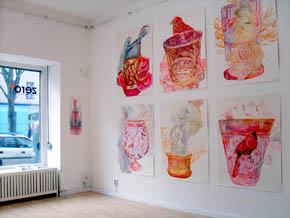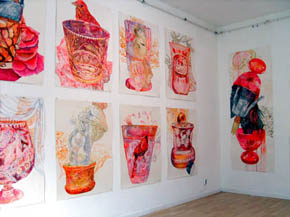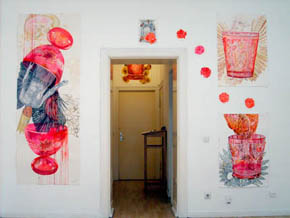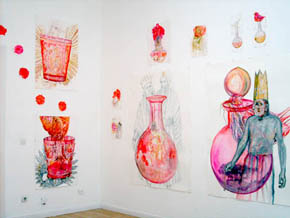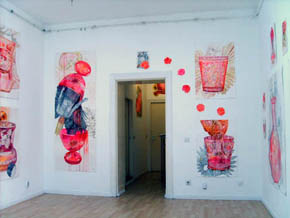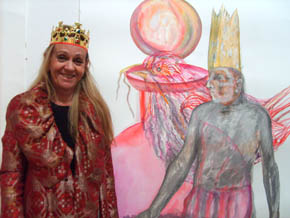 | In 1977 when I was on the D.A.A.D. in Berlin, I visited Pfaueninsel, an island inhabited by a 16th century alchemist named Johaan Kunckel, who made ‘ruby glass”. Werner Herzog made a film about this red glass called “Herz aus Glas.” Kunckel chose the island with its limited access to insure secrecy for his alchemical process and also as a precaution against fire, glass works were notorious for starting fires and were put outside of city centers. Kunckel’s glass works did eventually burn down in 1693, but the island forever was associated with Kunckel’s alchemical mysteries. When I visited the island in 1977, shards of the red glass could still be found. |
| ||||||||
In the reign of the endless winter the sun was a pale memory in the heavens and dark clouds covered the palaces of the East and the West. The Crusades in the East had depleted the kingdom’s army. At the White Palace in the West the bodies of the fallen were piled against the walls and blood poured down the steps staining the white marble. Fat black crows grew bloated on the corpses of the young men, and the stench became unbearable. The endless war had produced an endless supply of dead soldiers. In the East the young Moors were hurried to their graves in accordance with their religion; piles of shrouded bodies were buried along with those of the ancient warriors in walled cemeteries.
The officials in the White Palace seemed to take no notice; it was the people beyond the walls who grew more and more despondent. As the sons of the poor returned home from the Crusade dead and disfigured, the kingdom fell into a dark mood. The stench became worse and worse, the vultures and crows sat on the city walls. Mothers wept for their dead sons, as they have for centuries.
In the counting houses, the king’s men kept piling up the coinage. Vats of oil and gold from the East filled the treasury. Both foreign lands and the kingdom had been looted as the king and court became richer with each passing day. This is an old tale; an isolated king in a palace counting his money while the land becomes depleted and the people despair. There was no good queen to pray in the chapel for the soul of the kingdom.
The king had been a coward and had refused to go to battle as a young man; he had sent others out to die in his place. Instead he wore military garb and paraded about the decks of the royal ships. On the day the king was to parade about the city in his battle dress, he fell to the ground. He was bloated like a tick, his head was enlarged like a melon, and he could not stand on his swollen legs. His feverish madness was apparent to all. Doctors from every kingdom were called to cure the king because none of the royal physicians could help him. Finally after every known doctor had been tried and failed, the alchemist Johaan Kunckel and his female assistant Grafin were called by the chamberlains. This alchemist and his female partner kept the alchemical furnaces burning in their prayerful solitude.
Kunckel had a secret laboratory on the island Pfaueninsel. He was known for cures and for making Ruby Glass. His glass works was isolated to keep his process secret, and no visitors could embark on the island. The laboratory had been built by Graftin and Kunckel as a place to cure souls and make ruby glass. The furnaces were tended with the most constant care burning with an even consistency. The island was peaceful and rabbits and peacocks roamed the island’s gardens.
The Kings body was placed on a ship, and he was taken to Kunckel’s laboratory on Pfaueninsel. A long barge carried the body of the swollen king in its lead coffin. He kept crying out, “He who saves me will inherit my kingdom.” His distress grew. In the darkness of night, his boat docked on the island. Kunckel began to load the furnaces with beach wood and stoke the fires. Grafin blew wind into the alchemical furnace with bellows. The king was carried on a plank and was placed in the furnace.
Kunckel also brought in the body of the King of the Moors from the East. The Moor king had fallen into a similar state, he was black as pitch and had to be carried in a lead coffin. The Moors were the archenemies of the Kingdom. The royal troops had been in the East fighting the Moors in the Great Endless War. This Moor king was also placed in an oven by Kunckel. The King and the Moor were baked for three days. When the ovens opened two piles of ash were found in the two furnaces. Kunckel took the ash and combined it in a mortar and ground it with a pestle. Grafin added holy water from the chapel on the island.
The ash was combined with the dark liquid that had seeped into the pan at the bottom of each furnace place. Kunckel’s glass works used gold in its smallest molecular structure to make the blood red glass. This merged black essence and ash mixture was poured into a red glass beaker and was placed in the sun. Black crows began to fly out of the black liquid and into trees. The black liquid from the King and the Moor thickened and was then poured into a pan and placed in a slow oven made of brick. More of the liquid was sweat out and the dough began to make the form of a two headed man. Kunkel and his female apprentice prayed beside the oven for days. When the oven was opened out came a uniped with two heads. One head was the King and one was the Moor, the two heads looked at each other and shouted, “We are one.” The Uniped is like a coin; the dark brother and we are of the same coin, only different sides. We project our evil onto each other. This projection must be withdrawn for the process to continue.
The Uniped struggled to walk about the island and sat on a rock, crying and looking out at the shore. The two royal ships sat in the slips but now would never sail to their separate kingdoms. The Moor and the King were united in their grief. Kunckel came and led the Uniped to his laboratory. In Kunckel’s stone house they saw a table with a large red vile. Their tears were collected in the vile and were heated over a flame. In the red light a small woman began to grow in the vile. The Uniped continued to cry until all of the liquid from the tears filled the vile. The Uniped fell on the floor, an empty skin. Kunckel swept up the empty skin and threw it into the fire.
The liquid from the tears and the small woman were placed in an upright clay furnace for nine days. When the furnace was opened out came a Red Man. He crawled from the furnace and stood naked, a beautiful youth. Kunckel had Grafin make a royal costume for this young red prince of gold and red silk. The red prince wandered about the island exploring the castle and the buildings. In a grove of trees he came across a small temple to Venus. A red bird lit on his shoulder and told him to enter the temple. Inside he found a sleeping white queen cold as ice on a marble slab. She had slept for centuries and was clad in Greek robes. When he kissed her she awoke and her body began to turn red. Blood rushed through her veins and he recognized her as the tiny woman from the alchemists vile. On the floor of the Venus temple were sleeping priest and knights. They awoke and stumbled from the tomb shielding their eyes from the sight of the naked glowing red queen. They ran into the forest. The Venus queen told the prince of her long sleep through the centuries. She had fallen into a deep sleep when the very men sleeping in her tomb had destroyed her temples.
The newly red queen and the prince walked into the island forest until they came to a fountain. The red bird instructed them to bath in the water. They bathed naked in the fountain and began to glow red in the sunlight. They dipped into the waters and drank from the fountain. Their bodies were adolescent and resembled one another like a brother sister pair. The prince held her left hand in his left hand and proposed marriage. A white dove descended from the heavens and flew about the fountain. As they drank from the fountain, they were thrown together in a passion not known in the realm. There was copulation at once holy and then violent like two wolves then changing into two fawns. The waters of the fountain flowed red and sparkled in the sunlight.
The prince and the queen walked about the island climbing ladders and picking fruit from the trees. The baskets of fruit were loaded onto the two docked ships of the dead kings and were shipped to the East and West. They also collected vats of the red water from the fountain and placed it in red glass vials for shipment to the people suffering in the perpetual war. Red birds were sent in cages to sing. Prayers from the alchemist Kunckle and Grafin were sent along with the cargo. It is this red liquid, birds, prayers and fruit most needed in times of war. Old kings must die and be replaced by new ones, dances to ancient goddesses be performed, if the fields are to bring forth new crops.
It was now time to plan a royal wedding. The pair joined with Kunckle and Grafin to enter the island’s rose garden. Only a re-born king who has undergone death and transformation may enter the garden accompanied by his queen. The Queen handed the prince the garden key and the royal pair and Kunckel and Grafin entered. They walked into the great circle and sat among the red and white roses as the rose bushes shed gold coins. In the center of the great circle thy drew a second circle for a wedding pavilion. The sun fell upon the coins and reflected their rays back up to the heavens.
The coins began to multiply.
To build a pavilion would require a new architecture and a new architect. The building must spring from a vision, the dream of an architect. Massagers were sent to the four corners of the earth to find such a builder. At last an architect from India answered the call. A circle was drawn inside a square and cleared of all debris. Gold coins, diamonds and the feathers of red birds were placed in the circle with rose petals form the garden. The two pairs sat on the ground and Kunckel and Grafin prayed to bring down the red birds down from the heavens. White snow began to fall and the gardens was covered in soft white flakes. A calm descended on the island and there was a peaceful stillness.
The architect went to Kunckel’s glass works. Hundreds of sheets or red glass were made. A circular pavilion was constructed in the center of the garden with palm trees and roses and hundreds of pairs of peacocks. In front of the pavilion was a white castle with a male and female tower. The two towers were joined by a bridge. The red prince and the queen met on the bridge and the visitors below watched them embrace. Those entering the garden pavilion had to relinquish all hatred, fear, and selfishness and come in prayer and forgiveness. Each guest washed the feet of his brother and sister and wiped them with petals from the garden. Each guest then saluted the divinity found within each guest and bowed. Each participant made a vow of forgiveness as they entered into the structure. In the red glass house there was no dark and no light, only warmth and eros. The red prince came forth to marry the queen, goddess heavens and earth. Kunckel and Grafin built a red pavilion to praise the return of erotic passion, divine love, and mystical union.
The planners of endless war can never visit such an island. They would have to relinquish all they know. For the island is a place where birds and rabbits and small forest creatures roam with the royal pairs and peace pervades. Music, erotic play, gardening, alchemy and prayers to the heavens chart the path of the soul. The men of war can never know such delights. Pfaueninsel is no ordinary Utopia. To come to the island requires that one must die and change form. The soul, long forgotten in the West, grows here in the rose garden, tended by the alchemist Kunckel and his mistress Grafin. The red birds wrap each soul in their wings and place them carefully in the petals of the growing roses. Red tinted waters gently feed the roots of the bushes, and the souls grow in peace.
Ann McCoy
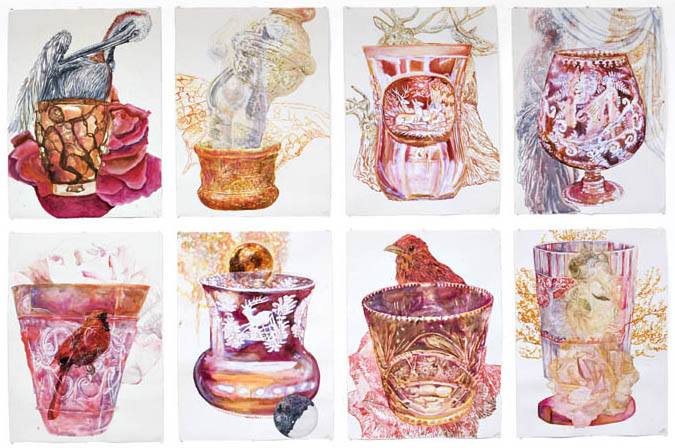
THE ALCHEMICAL RUBEDO
The alchemists were not simply chemists; they developed a symbolic language to describe spiritual transformation in the psyche. Due to the problem of heresy, alchemical symbolism could include content banned by the church such as sexual passion. In the most general way, alchemy has to do with incarnation, bringing spirit into matter. The alchemists also understood the circulatio. The circulatio means that the process is circular. In a person’s life there will be periods of depression, suffering, enlightenment, etc. that will reoccur at in the life of the individual. Much New Age thought does not acknowledge the role of depression or suffering as a vehicle for positive change. The alchemist embraced the dark as well as the light and worked to bring the opposites together.
The basic stages of the process are the nigredo (the black state of depression), the albedo (the white stage often associated with enlightenment), the rubedo (when blood and passion enter the work), the solutio (when things re dissolved in solution), and the separatio (when contents are separated). Other stages exist in the process, but these are some of the most common.
“In the state of ‘whiteness’ one does not live in the true sense of the word. It is a sort of abstract, ideal state. In order to make it come alive it must have ‘blood’, it must have what the alchemists called the rubedo, the ‘redness’ of life. Only the experience of being can transform this ideal state into a fully human mode of existence. Blood alone can reanimate a glorious state of consciousness in which the last traces of blackness is dissolved, in which the devil no longer has an autonomous existence, but rejoins the profound unity of the psyche. Then the opus magnum is finished: the human soul is completely integrated.” Carl Jung
First there is the nigredo, the blackness, the ‘dark night of the soul’. Then the light enters the process bringing consciousness and enlightenment. The moonlight and the particles of light herald the coming of the light from the sun, consciousness. This light stage of the work is called the albedo. The redness follows; this redness is called the rubedo. This is warmth coming from the sun but now an emotional relationship ha to the contents of the unconscious has entered the picture. Redness is Eros, passion, and pneuma (spirit).
My work SPLENDOR SOLIS came from a dream. A red man came out of a bog of rotted corpses and was greeted by a red queen. It differs from the alchemical text, the Splendor Solis, where the queen is white. In the alchemical text the red man represents the Moor who will impregnate the Queen and bring about a new king in the form of a prince. I have written a fairy tale about this process.
My fairy tale takes place on an island off Berlin called Pfaueninsel (peacock island). The island was the home of Johaan Kunckel and alchemist who made red glass. For me the Ruby Glass was a perfect symbol of the rubedo. This exhibition contains the watercolors for my January 2008 Berlin exhibition.Ann McCoy
The Transformation of the King and the Alchemist of Pfaueninsel
In 2005 I began writing fairy tales with alchemical themes similar to “The Chemical Wedding of Christian Rosenkrantz”, written in 1459.
For me, alchemical model is not antiquated and is much needed in our time. In alchemy, the shadow, our dark partner we project onto others, must be acknowledged and integrated. The pairs of opposites are brought together and transformed into a new third element. In our age of black and white thinking, with the shadow projected onto the Arab and others, this model provides a welcome change. Alchemy has to do with transformation, transmutation, and changes in the inner life which become manifest in the outer world. Without the transformation of the individual, there can be no transformation in the collective. Alchemy connects the inner transformation process through fantasy to the outer world.
My first exhibition featuring alchemical fairy tale themes was “The Death and Transformation of the Monkey King” at KHOJ in New Delhi. George Bush as a monkey king was put through an alchemical process of death and dismemberment and was baked in an oven and reborn in a golden egg as Hanuman the Indian monkey king. I adapted a third century Alexandrian alchemical recipe to transform a sick head of state into a divinity. Mary Renault uses this motif in her novel “The King Must Die.” An old king represents the ruling consciousness in a land. When the land becomes arid and the crops fail, the king is killed and buried in the fields. The new king (his son) represents a new perspective, which will bring fertility to the land.
After this exhibition I began writing fairy tales for our time, which included themes of both personal and collective transformation. The fairy tale is a powerful way to connect with the public and present alchemical models for change. I was also able to combine my writing with my art in a new way.
In 1977 when I was on the D.A.A.D. in Berlin, I visited Pfaueninsel, an island inhabited by a 16th century alchemist named Johaan Kunckel, who made ‘ruby glass”. Werner Herzog made a film about this red glass called “Herz aus Glas.” Kunckel chose the island with its limited access to insure secrecy for his alchemical process and also as a precaution against fire, glass works were notorious for starting fires and were put outside of city centers. Kunckel’s glass works did eventually burn down in 1693, but the island forever was associated with Kunckel’s alchemical mysteries. When I visited the island in 1977, shards of the red glass could still be found.
Pfaueninsel a hundred years later. became a retreat for Frederich Wilhelm II and the Potsdam Court. His mistress Grafin Lichtenau supervised many of the plans for a castle, a game park, rose gardens and pavilions for musical and theatrical pleasures. Thousands of plants including exotic palms for the Palm House and animals were brought in to create a South Sea fantasy for the court. The island was created as a natural paradise on the model of Rousseau. A zoo with peacocks gave the island its name.
The various elements present in the history of the island fascinated me and I began to write a fantasy history of the island using these historical elements as a basis for my fairy tale. The rose garden, the peacock, the furnace, and the island appear in many alchemical texts. These alchemical themes were also present on Pfaueninsel in structures developed by the court Rosicrucian Christoph von Wolner who was instrumental in the planning of the Neuer Garten, and Jacob’s Well, Temple of Serapus and placement of statues like Dianna of Ephesus on Pfaueninsel. This Rosicrucian influence was prevalent in German courts such as Frederick and Elizabeth’s at Heidelberg in the Papatinate from 1613 onwards.
I would condense several hundred years of the island’s history into a fairy tale about a King, his mistress, and an alchemist. Two important German fairy tales steeped in alchemical symbolism would be models for my tale: “The Chemical Wedding of Christan Rosenkreutz” by an unknown author, and Goethe’s “Fairy Tale of the Green Snake and the Beautiful Lily.”
The fairy tale will hopefully be performed either on the island or in a Baroque theatre like the theater at Potsdam this coming summer. A video could also be shot of this performance. Actors from New York’s THEATERLAB and the Berlin group OPENSPACE will perform the fairy tale.
I have spent thirty years reading alchemy both in Rome and in Zurich. I worked with C.G. Jung’s main heir Dr. C. A. Maier in Zurich for twenty -five years doing studies in depth psychology and alchemy. When I was on the Prix de Rome, I read alchemy at the Vatican Library and the Palazzo Corsini. My main interest is late German alchemy, mainly Michael Meier, the founder of the Rosicrucian Order. The island was a Rosicrucian and alchemical fantasy. I want to use it like a stage set for my alchemical fairy tale which bridges all of these interests.
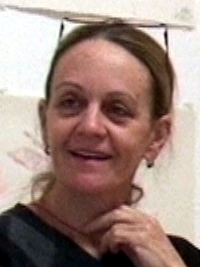 Ann McCoy
Ann McCoy
